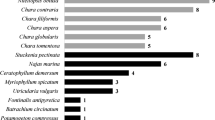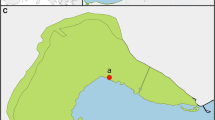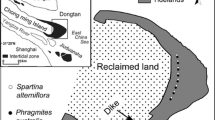Abstract
In shallow lakes, submerged macrophytes contribute to the stabilization of the clear water state. If lost, a number of mechanisms prevent re-colonization. Lake Müggelsee (730 ha) lost its submerged vegetation due to increasing eutrophication and switched to phytoplankton dominance in 1970. After the reduction of nutrient loading in 1990, Potamogeton pectinatus L. started re-colonizing the lake. During the following years, it spread at a mean rate of 2.5 ha per year to all available areas <80 cm depth. Between 1993 and 1999, decreasing maximum biomass indicated hampered growth. Exclosure experiments revealed that herbivory reduced the aboveground biomass by more than 90%. Both waterfowl and fish were found to contribute to the grazing pressure despite a low abundance of the known herbivorous fish species and waterfowl in spring and summer. Protection of stands against grazing resulted in higher biomass of shoots, whereas shoot and tuber density did not change. Both shading by phytoplankton and periphyton, as well as grazing pressure, prevented the submerged vegetation of Lake Müggelsee from developing back to a dense zone that contributed to the reduction of turbidity.
Similar content being viewed by others
References
E. Driescher H. Behrendt G. Schellenberger R. Stellmacher (1993) ArticleTitleLake Müggelsee and its environment – natural conditions and anthropogenic impacts International Review of ges Hydrobiology 78 327–343 Occurrence Handle1:CAS:528:DyaK2cXhvF2rt7s%3D
S. Körner (2001) ArticleTitleDevelopment of submerged macrophytes in shallow Lake Müggelsee (Berlin, Germany) before and after its switch to the phytoplankton-dominated state Archives of Hydrobiology 152 395–409
S. Körner (2002) ArticleTitleLoss of submerged macrophytes in shallow lakes in North-Eastern Germany International Review of Hydrobiology 87 375–384 Occurrence Handle10.1002/1522-2632(200207)87:4<375::AID-IROH375>3.0.CO;2-7
S. Körner T. Dugdale (2003) ArticleTitleIs roach herbivory preventing re-colonization of a shallow lake with submerged macrophytes? Hydrobiologia 506 497–501 Occurrence Handle10.1023/B:HYDR.0000008561.67513.ec
T. Lauridsen E. Jeppesen F. O. Andersen (1993) ArticleTitleColonization of submerged macrophytes in shallow fish manipulated Lake Væng: impact of sediment composition and waterfowl grazing Aquatic Botany 46 1–15 Occurrence Handle10.1016/0304-3770(93)90061-Z
S. F. Mitchell R. T. Wass (1996) ArticleTitleGrazing black swans (Cygnus atratus), physical factors, and the growth and loss of aquatic vegetation in a shallow lake Aquatic Botany 55 205–215 Occurrence Handle10.1016/S0304-3770(96)01077-7
S. L. Nielsen K. Sand-Jensen (1991) ArticleTitleVariation in growth rates of submerged rooted macrophytes Aquatic Botany 39 109–120 Occurrence Handle10.1016/0304-3770(91)90026-2
T. Ozimek K. Prejs A. Prejs (1986) ArticleTitleBiomass and growth rate of Potamogeton pectinatus L. in lakes of different trophic state Ekol Pol 34 125–131
M. R. Perrow J. H. Schutten J. R. Howes T. Holzer J. Madgwick A. J. D. Jowitt (1997) ArticleTitleInteractions between coot (Fulica atra) and submerged macrophytes: the role of birds in the restoration process Hydrobiologia 342/343 241–255 Occurrence Handle10.1023/A:1017007911190
G. L. Phillips D. Eminson B. Moss (1978) ArticleTitleA mechanism to account for macrophyte decline in progressively eutrophicated freshwaters Aquatic Botany 4 103–126 Occurrence Handle10.1016/0304-3770(78)90012-8
A. Prejs (1984) ArticleTitleHerbivory by temperate freshwater fishes and its consequences Environmental Biology of Fishes 10 281–296 Occurrence Handle10.1007/BF00001481
E. Roberts J. Kroker S. Körner A. Nicklisch (2003) ArticleTitleThe role of periphyton during the re-colonization of a shallow lake with submerged macrophytes Hydrobiologia 506 525–530 Occurrence Handle10.1023/B:HYDR.0000008560.73832.1c
M. Søndergaard L. Bruun T. Lauridsen E. Jeppesen T. W. Madsen (1996) ArticleTitleThe impact of grazing waterfowl on submerged macrophytes: in situ experiments in a shallow eutrophic lake Aquatic Botany 53 73–84 Occurrence Handle10.1016/0304-3770(95)01013-0
G. M. Dijk ParticleVan A. W. Breukelaar R. Gijlstra (1992) ArticleTitleImpact of light climate history on seasonal dynamics of a field population of Potamogeton pectinatus L. during a three year period (1986–1988) Aquatic Botany 43 17–41 Occurrence Handle10.1016/0304-3770(92)90011-7
E. Donk ParticleVan E. Deckere ParticleDe G. P. Klein Breteler J. T. Meulemans (1994) ArticleTitleHerbivory by waterfowl and fish on macrophytes in a biomanipulated lake: effects on long-term recovery Verh Internat Verein Limnol 25 2139–2143
Author information
Authors and Affiliations
Corresponding author
Rights and permissions
About this article
Cite this article
Hilt, S. Recovery of Potamogeton pectinatus L. stands in a shallow eutrophic lake under extreme grazing pressure. Hydrobiologia 570, 95–99 (2006). https://doi.org/10.1007/s10750-006-0167-3
Issue Date:
DOI: https://doi.org/10.1007/s10750-006-0167-3




